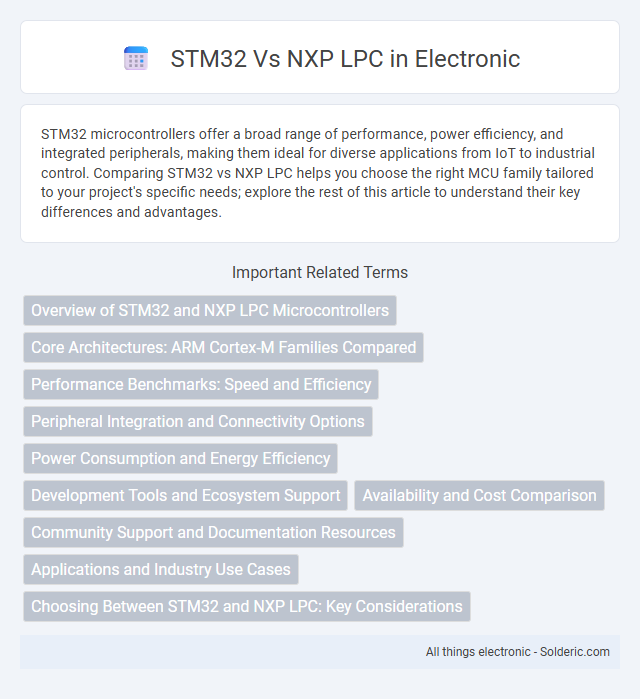STM32 microcontrollers offer a broad range of performance, power efficiency, and integrated peripherals, making them ideal for diverse applications from IoT to industrial control. Comparing STM32 vs NXP LPC helps you choose the right MCU family tailored to your project's specific needs; explore the rest of this article to understand their key differences and advantages.
Comparison Table
| Feature | STM32 | NXP LPC |
|---|---|---|
| Manufacturer | STMicroelectronics | NXP Semiconductors |
| Core Architecture | ARM Cortex-M0, M3, M4, M7, M33 | ARM Cortex-M0, M0+, M3, M4, M7 |
| Clock Speed | Up to 480 MHz (STM32H7 series) | Up to 150 MHz (LPC5500 series) |
| Memory | Flash up to 2 MB, SRAM up to 1 MB | Flash up to 2 MB, SRAM up to 640 KB |
| Power Consumption | Ultra low power options, Dynamic voltage scaling | Low power with Power Management Unit (PMU) |
| Peripherals | USB, CAN, Ethernet, ADC, DAC, Timers, LCD | USB, CAN, Ethernet, ADC, DAC, Timers, LCD |
| Development Ecosystem | STM32CubeMX, STM32CubeIDE, wide third-party support | MCUXpresso IDE, SDK, extensive middleware support |
| Typical Applications | Industrial, automotive, consumer electronics, IoT | Industrial automation, IoT, consumer electronics |
| Price Range | Affordable to mid-range pricing | Competitive pricing, sometimes lower in entry-level |
Overview of STM32 and NXP LPC Microcontrollers
STM32 microcontrollers, developed by STMicroelectronics, are widely recognized for their high-performance ARM Cortex-M cores, extensive peripheral set, and robust ecosystem supporting applications from automotive to industrial automation. NXP LPC series features ARM Cortex-M based microcontrollers designed for low power consumption, integrated security features, and efficient real-time processing suitable for embedded applications. Your choice between STM32 and NXP LPC depends on specific project requirements such as processing power, power efficiency, and peripheral integration.
Core Architectures: ARM Cortex-M Families Compared
STM32 microcontrollers predominantly utilize ARM Cortex-M0, M3, M4, and M7 cores, offering scalable performance from low-power applications to high-speed digital signal processing. NXP LPC series features ARM Cortex-M0+, M3, M4, and M33 cores, emphasizing security enhancements and ultra-low power consumption in IoT and embedded devices. Both STM32 and NXP LPC provide diverse ARM Cortex-M families tailored to specific application needs, balancing performance, power efficiency, and security features.
Performance Benchmarks: Speed and Efficiency
STM32 microcontrollers, based on ARM Cortex-M cores, often deliver higher clock speeds and more efficient power management compared to many NXP LPC series, enhancing real-time performance in embedded applications. Benchmark tests reveal STM32 devices excel in executing complex algorithms and DSP routines faster due to optimized architectures and higher instruction throughput. NXP LPC microcontrollers provide competitive performance but generally exhibit slightly lower raw speed and efficiency metrics in benchmarks focused on intensive computation and low-power operation.
Peripheral Integration and Connectivity Options
STM32 microcontrollers offer extensive peripheral integration including advanced ADCs, DACs, and a wide range of timers, facilitating diverse real-time applications. NXP LPC series stands out with robust connectivity options such as USB, Ethernet, CAN, and high-speed SPI interfaces, ensuring seamless communication in complex embedded systems. Both platforms support extensive UART and I2C peripherals, but STM32 often provides more scalable configurations for flexible design needs.
Power Consumption and Energy Efficiency
STM32 microcontrollers are renowned for their ultra-low power modes and energy-efficient Cortex-M cores, making them ideal for battery-powered applications. NXP LPC devices also emphasize low power consumption with features like deep-sleep modes and optimized power domains, but STM32's extensive power management options often provide superior flexibility. Your choice should consider specific application requirements, as STM32 generally leads in detailed power optimization capabilities.
Development Tools and Ecosystem Support
STM32 microcontrollers offer an extensive ecosystem with STM32CubeMX for hardware configuration and comprehensive support in popular IDEs like Keil, IAR, and STM32CubeIDE, enabling smooth code generation and debugging. NXP LPC series benefits from MCUXpresso IDE, which integrates SDKs and powerful debugging tools tailored for LPC devices, enhancing development efficiency. Both ecosystems provide rich middleware libraries and community support, but STM32's broader third-party tool integration often accelerates prototyping and commercial product development.
Availability and Cost Comparison
STM32 microcontrollers generally offer wider availability due to STMicroelectronics' extensive global distribution network and higher production volumes, which also contribute to competitive pricing across various STM32 product lines. NXP LPC series devices may have slightly higher unit costs and less consistent availability depending on the region, influenced by NXP's more specialized market focus and supply chain constraints. For projects requiring rapid prototyping or large-scale manufacturing, STM32 tends to be more cost-effective and accessible compared to NXP LPC microcontrollers.
Community Support and Documentation Resources
STM32 microcontrollers boast extensive community support, driven by STMicroelectronics' widespread adoption and active forums like ST Community and platforms such as GitHub and Stack Overflow. NXP LPC series also offers solid documentation through NXP's official MCUXpresso SDK and user guides but features comparatively smaller community-driven resources. Access to abundant example codes, libraries, and troubleshooting discussions positions STM32 as a preferred choice for developers seeking robust support and comprehensive documentation resources.
Applications and Industry Use Cases
STM32 microcontrollers from STMicroelectronics are widely adopted in automotive, industrial automation, consumer electronics, and IoT applications due to their extensive peripheral set, real-time performance, and robust ecosystem. NXP LPC series excels in motor control, embedded systems, and communication devices, offering high integration and scalability tailored for industrial automation and smart home products. Both platforms support advanced connectivity and security features critical for modern industrial IoT and automotive safety systems.
Choosing Between STM32 and NXP LPC: Key Considerations
Choosing between STM32 and NXP LPC microcontrollers depends on factors like processing power, peripheral sets, and ecosystem support. STM32 offers a broad range of ARM Cortex-M cores with extensive libraries and community resources, while NXP LPC excels in real-time applications with robust connectivity options and low-power modes. Evaluate project requirements such as software compatibility, power consumption, and development tools to determine the optimal microcontroller platform.
STM32 vs NXP LPC Infographic

 solderic.com
solderic.com